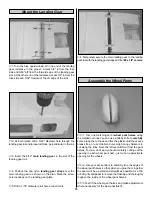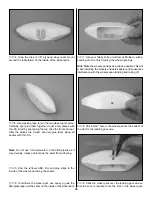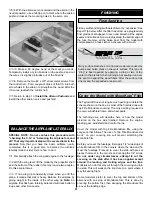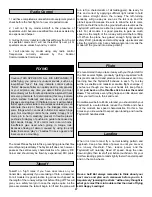
If a club and flying site are not available, find a large, grassy
area at least 6 miles away from houses, buildings and
streets and any other R/C radio operation like R/C boats
and R/C cars. A schoolyard may look inviting but is too close
to people, power lines and possible radio interference.
Inspect your radio installation and confirm that all the control
surfaces respond correctly to the transmitter inputs. The
engine operation must also be checked by confirming that
the engine idles reliably and transitions smoothly and
rapidly to full power and maintains full power indefinitely.
The engine must be “broken-in” on the ground by running it
for at least two tanks of fuel following the engine
manufacturer's recommendations for break-in. Make sure all
screws remain tight, that the hinges are secure and that the
prop is on tight.
Whenever you go to the flying field, check the operational
range of the radio before the first flight of the day. First,
make sure no one else is on your frequency (channel). With
your transmitter on and the transmitter antenna collapsed,
you should be able to walk at least 100 feet away from the
model and still have control. While you work the controls,
have a helper stand by your model and tell you what the
control surfaces are doing. Repeat this test with the engine
running at various speeds with a helper holding the model.
If the control surfaces are not always responding correctly,
do not fly! Find and correct the problem first. Look for loose
servo connections or corrosion, loose bolts that may cause
vibration, a defective on/off switch, low battery voltage or a
defective receiver battery, a damaged receiver antenna, or
a receiver crystal that may have been damaged from a
previous crash. If the radio appears to only be affected when
the engine is running, try moving your receiver and receiver
antenna farther away from the engine.
Note: Failure to follow these safety precautions may
result in severe injury to yourself and others.
Keep all engine fuel in a safe place, away from high heat,
sparks or flames, as fuel is very flammable. Do not smoke
near the engine or fuel; and remember that the engine exhaust
gives off a great deal of deadly carbon monoxide. Therefore
do not run the engine in a closed room or garage.
Get help from an experienced pilot when learning to
operate engines.
Use safety glasses when starting or running engines.
Do not run the engine in an area of loose gravel or sand; the
propeller may throw such material in your face or eyes.
Keep your face and body as well as all spectators away from the
plane of rotation of the propeller as you start and run the engine.
Keep items such as these away from the prop: loose
clothing, shirt sleeves, ties, scarfs, long hair or loose objects
(pencils, screw drivers) that may fall out of shirt or jacket
pockets into the prop.
Use a “chicken stick” device or electric starter; follow
instructions supplied with the starter or stick. Make certain
the glow plug clip or connector is secure so that it will not
pop off or otherwise get into the running propeller.
Make all engine adjustments from behind the rotating propeller.
The engine gets hot! Do not touch it during or after
operation. Make sure fuel lines are in good condition so fuel
will not leak onto a hot engine causing a fire.
To stop the engine, cut off the fuel supply by closing off the fuel
line or follow the engine manufacturer's recommendations. Do
not use hands, fingers or any body part to try to stop the
engine. Do not throw anything into the prop of a running engine.
Read and abide by the following Academy of Model
Aeronautics Official Safety Code:
1. I will not fly my model aircraft in sanctioned events, air
shows, or model flying demonstrations until it has been
proven to be airworthy by having been previously
successfully flight tested.
2. I will not fly my model aircraft higher than approximately
400 feet within 3 miles of an airport without notifying the
airport operator. I will give right of way to and avoid flying in
the proximity of full-scale aircraft. Where necessary an
observer shall be used to supervise flying to avoid having
models fly in the proximity of full-scale aircraft.
3. Where established, I will abide by the safely rules for the
flying site I use and I will not willfully and deliberately fly my
models in a careless, reckless and/or dangerous manner.
7. I will not fly my model unless it is identified with my name
and address or AMA number, on or in the model.
9. I will not operate models with pyrotechnics (any device
that explodes, burns, or propels a projectile or any kind).
General
AMA SAFETY CODE (
EXCERPT
)
Engine Safety Precautions
Range Check Your Radio
Ground Check the Model
46



































